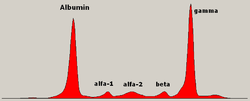Multiple myeloma
Multiple myeloma is a type of cancer involving the plasma cells. Some symptoms of the multiple myeloma are bone pain, kidney failure, recurring infections and anemia. It is treated with chemotherapy. A commonly used chemotherapy regimen is the vincristine, adriamycin, and dexamethasone. thalidomides, velcades, melphalans, prednisones and interferons have also been used.
Multiple Myeloma Media
Plasmablast, Wright stain, in a case of multiple myeloma of plasmablastic type.
Serum protein electropherogram showing a paraprotein (peak in the gamma zone) in a person with multiple myeloma
Bone marrow aspirate showing the histologic correlate of multiple myeloma under the microscope, H&E stain
Micrograph showing myeloma cast nephropathy in a kidney biopsy: Hyaline casts are PAS positive (dark pink/red – right of image). Myelomatous casts are PAS negative (pale pink – left of image), PAS stain.








